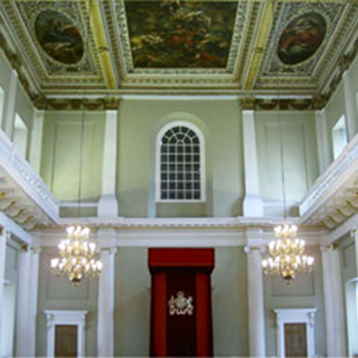The Banqueting House, London, England
Originally part of the expansive Palace of Whitehall, the Banqueting Hall was designed by Inigo Jones in 1619 and completed in 1622. It was to replace a previous one destroyed by fire. For the overall building design, Architect Jones followed the principles of classical architecture of Rome and the Renaissance ideas of Palladio. The somber, stone Banqueting House formed a startling contrast to brightly painted Tudor buildings that surrounded it. Perhaps because of this or its association with masques (a popular form of court entertainment combining elements of a costume ball and theater), its architecture failed to attract much admiration in its day.
The fine proportions of the building are evident on the exterior and interior. The exterior elevation has three levels: a rusticated base; a first story with a series of windows crowned by alternating segmental and triangular pediments separated by Ionic columns, and pilasters that; and a second story with Corinthian columns and pilasters that correspond to those below, as do the windows and with a garland swag tying the capitals together beneath the flat balustraded roof. The Banqueting Hall underwent its most complete restoration in 1829 under Sir John Soane, and the uniform Portland stone on the exterior is due to his hand.
Inside at street level is the Undercroft which was originally designed as a drinking den for James I. Upon ascending the staircase, the magnificence of the Banqueting Hall is revealed. The hall measures 55 feet wide by 110 feet long and 55 feet high. For the elaborately decorated architrave, cornice, and frieze, Inigo Jones followed Venetian models.
However, the outstanding aspect of the Banqueting Hall is the ceiling, painted by Peter Paul Rubens. Commissioned by Charles I, the canvasses were painted by Rubens and his studio in Antwerp 1630 to 1634 and installed in the Banqueting Hall in 1636. Using a vocabulary of allegory and symbol, he created dramatic scenes that celebrate the monarchy.
The 2007 Pritzker Architecture Prize ceremony took place in the Banqueting Hall with the participation of the Mayor of London, Martha Thorne, Executive Director, Lord Palumbo, Chair of the Jury ,Thomas J. Pritzker, President of The Hyatt Foundation, and of course, Sir Richard Rogers, the 2007 laureate.
Read Richard Rogers' Ceremony Acceptance Speech
Read Tom Pritzker's Ceremony Speech
